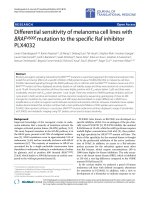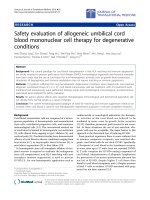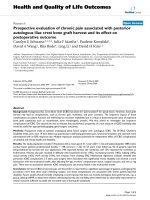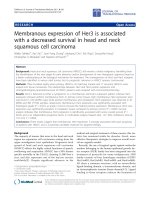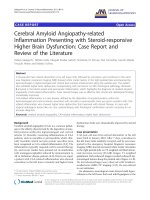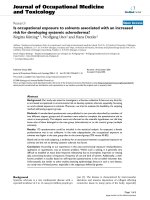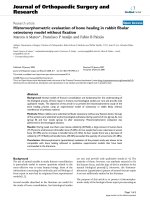báo cáo hóa học: " Prospective evaluation of chronic pain associated with posterior autologous iliac crest bone graft harvest and its effect on postoperative outcome" potx
Bạn đang xem bản rút gọn của tài liệu. Xem và tải ngay bản đầy đủ của tài liệu tại đây (268.62 KB, 8 trang )
BioMed Central
Page 1 of 8
(page number not for citation purposes)
Health and Quality of Life Outcomes
Open Access
Research
Prospective evaluation of chronic pain associated with posterior
autologous iliac crest bone graft harvest and its effect on
postoperative outcome
Carolyn E Schwartz*
1,2,3
, Julia F Martha
1
, Paulette Kowalski
1
,
David A Wang
1
, Rita Bode
4
, Ling Li
1
and David H Kim
1,2
Address:
1
Department of Orthopedics, New England Baptist Hospital, Boston, Masschusetts, USA,
2
Departments of Medicine and Orthopaedic
Surgery, Tufts School of Medicine, Boston, Massachuesetts, USA,
3
DeltaQuest Foundation, Inc., Concord, Massachuesetts, USA and
4
Department
of Physical Medicine & Rehabilitation, Feinberg School of Medicine, Northwestern University, Chicago Illinois, USA
Email: Carolyn E Schwartz* - ; Julia F Martha - ;
Paulette Kowalski - ; David A Wang - ; Rita Bode - ;
Ling Li - ; David H Kim -
* Corresponding author
Abstract
Background: Autogenous Iliac Crest Bone Graft (ICBG) has been the "gold standard" for spinal fusion. However, bone graft
harvest may lead to complications, such as chronic pain, numbness, and poor cosmesis. The long-term impact of these
complications on patient function and well-being has not been established but is critical in determining the value of expensive
bone graft substitutes such as recombinant bone morphogenic protein. We thus aimed to investigate the long-term
complications of ICBG. Our second aim was to evaluate the psychometric properties of a new measure of ICBG morbidity that
would be useful for appropriately gauging spinal surgery outcomes.
Methods: Prospective study of patients undergoing spinal fusion surgery with autologous ICBG. The SF-36v2, Oswestry
Disability Index, and a new 14-item follow-up questionnaire addressing persistent pain, functional limitation, and cosmesis were
administered with an 83% response rate. Multiple regression analyses examined the independent effect of ICBG complications
on physical and mental health and disability.
Results: The study population included 170 patients with a mean age of 51.1 years (SD = 12.2) and balanced gender (48% male).
Lumbar fusion patients predominated (lumbar = 148; cervical n = 22). At 3.5 years mean follow-up, 5% of patients reported
being bothered by harvest site scar appearance, 24% reported harvest site numbness, and 13% reported the numbness as
bothersome. Harvest site pain resulted in difficulty with household chores (19%), recreational activity (18%), walking (16%),
sexual activity (16%), work activity (10%), and irritation from clothing (9%). Multivariate regression analyses revealed that
persistent ICBG complications 3.5 years post-surgery were associated with significantly worse disability and showed a trend
association with worse physical health, after adjusting for age, workers' compensation status, surgical site pain, and arm or leg
pain. There was no association between ICBG complications and mental health in the multivariate model.
Conclusion: Chronic ICBG harvest site pain and discomfort is reported by a significant percentage of patients undergoing this
procedure more than three years following surgery, and these complications are associated with worse patient-reported
disability. Future studies should consider employing a control group that does not include autologous bone graft harvest, e.g., a
group utilizing rhBMP, to determine whether eliminating harvest-site morbidity does indeed lead to observable improvement in
clinical outcome sufficient to justify the increased cost of bone graft substitutes.
Published: 29 May 2009
Health and Quality of Life Outcomes 2009, 7:49 doi:10.1186/1477-7525-7-49
Received: 25 March 2009
Accepted: 29 May 2009
This article is available from: />© 2009 Schwartz et al; licensee BioMed Central Ltd.
This is an Open Access article distributed under the terms of the Creative Commons Attribution License ( />),
which permits unrestricted use, distribution, and reproduction in any medium, provided the original work is properly cited.
Health and Quality of Life Outcomes 2009, 7:49 />Page 2 of 8
(page number not for citation purposes)
Introduction
Autologous iliac crest bone graft (ICBG) harvest is a com-
mon component of many spinal surgical procedures.
Although historically considered the "gold standard"
source of bone graft material, autograft bone is associated
with numerous disadvantages, primarily related to addi-
tional morbidity incurred at the harvest site. Several stud-
ies have identified a surprisingly high rate of
complications associated with autologous bone graft har-
vest, ranging from 9–49% [1-10]. The most troublesome
complication has been development of acute and chronic
donor site pain. In the setting of anterior cervical fusion
surgery, pain associated with autograft harvest often over-
shadows pain from the primary surgical site [11]. A per-
ceived high rate of donor site pain has been one of the
strongest factors driving a sustained search for alternatives
to autograft, such as allograft bone, ceramics, and biolog-
ics including recombinant human bone morphogenetic
proteins (rhBMPs). Recent clinical trials have demon-
strated excellent biological potency of rhBMPs that may
even surpass the efficacy of autograft in terms of promot-
ing spinal fusion [12]. Unfortunately, the high cost of
rhBMPs suggests that appropriate initial applications for
rhBMPs will be limited.
Various strategies have been applied in an effort to reduce
the patient's experience of postoperative donor site pain,
including administration of local anesthesia with or with-
out narcotics, as separate injections or as an infusion [13].
Postoperative injection of long-acting anesthetic (e.g.,
bupivacaine hydrochloride 0.25%) reduces postoperative
pain in the acute period, and addition of morphine
appears to have an added benefit [14,15]. Use of an ind-
welling catheter to administer a continuous infusion of
anesthetic in the early postoperative period does not
appear to decrease donor site pain and may increase the
risk of wound infection at the catheter site [16]. Local
anesthesia has not been shown to reduce the rate of
chronic donor site pain. Attempts have been made to
reduce morbidity by alterations in the technique of ICBG
harvesting [17,18]. Keeping the outer and inner cortical
tables intact does not reduce the severity of pain at the
donor site [19]. Closed methods of graft harvesting with
cylindrical osteotomes and percutaneous needle tech-
niques have been used successfully in craniofacial surgery
to retrieve small quantities of cancellous bone graft with
reduced morbidity but cannot be used for corticocancel-
lous graft harvest and do not result in sufficient quantity
of graft for most spinal applications [20,21].
Complete avoidance of autologous bone graft harvest is
the only way to eliminate the significant risk of chronic
donor site pain. Unfortunately, the high cost of effective
alternatives such as rhBMPs prohibits widespread use; and
other options such as allograft, synthetic substitutes, and
non rhBMP so-called factor- or cell-based substitutes have
been associated with less favorable clinical results. The
purpose of this study is to investigate the long-term
impact of the ICBG complications on patient function
and well-being in a cohort of patients undergoing autolo-
gous ICBG harvest for various spinal procedures. We also
aimed to evaluate the psychometric properties of a new
measure of ICBG morbidity that would be useful for
appropriately gauging spinal surgery outcomes.
Materials and methods
This prospective single institution study involved spinal
fusion patients who had undergone autologous ICBG har-
vest as a component of their surgery between 2003 and
2005. During the fusion procedure, a separate incision
was made over the posterior iliac crest through the subcu-
taneous tissue down to the fascia, where subperiosteal dis-
section was used to expose the outer table of the ilium. A
retractor was placed into the wound under direct visuali-
zation, and cortical and cancellous bone graft strips were
harvested. No patients had indwelling local anesthetic
infusion catheters and no patients had bone graft harvest
of both tables. There were no hernias related to the bone
graft harvest site. There was no measurement of bone graft
volume made for each surgery. All wounds were closed in
layered fashion with absorbable suture material. Local
anesthetic was infiltrated into the bone graft harvest site.
The patients with increased post-operative graft harvest
site pain were not treated with a pre-specified protocol.
They were treated on an individual basis at the discretion
of the surgeon. The most common treatments included
oral narcotics, nonsteroidal anti-inflammatory medica-
tion, topical anesthetic patches (i.e., Lidoderm patches),
and hot/cold therapy. We were unable to discern a clear
advantage in terms of one treatment modality over
another, but this was not a predefined question of the
study design.
We implemented the study using the Dillman Tailored
Design Method [22], a detail-oriented survey implemen-
tation method that relies on empirically documented
techniques for maximizing response rate. Patients pro-
vided written authorization for release of medical record
data and informed consent for this study. This study was
approved by the New England Baptist Hospital Institu-
tional Review Board for the protection of human subjects
(IRB Protocol 2003–006).
Outcomes were measured using the Short-Form-36v2 (SF-
36v2) [23], the Oswestry Disability Index (ODI; for lum-
bar patients) or Neck Disability Index (NDI; for cervical
patients) [24], and Visual Analogue Scale (VAS) items for
surgical site pain and arm or leg pain. Additionally, two
new study-specific questionnaires were used. At baseline,
an 11-item questionnaire assessed pain syndrome history,
Health and Quality of Life Outcomes 2009, 7:49 />Page 3 of 8
(page number not for citation purposes)
tolerance to pain, and use of narcotic or anti-depressant
medications. Post-operatively, a new 10-item ICBG Ques-
tionnaire assessed the presence or absence of persistent
pain, functional limitation, and cosmesis at the ICBG site
(see Additional file 1). We did psychometric analyses of
the ICBG pre-operative and post-operative questionnaires
to determine how the data should be used in subsequent
analyses. T-tests and chi-squared tests compared the base-
line and follow-up samples on demographic characteris-
tics to assess possible selection bias in this study.
Multivariate linear regression examined the independent
effect of ICBG complications on physical and mental
health, and disability, after adjusting for age and workers'
compensation status, variables presumed to be associated
with worse outcomes. The multivariate model also
adjusted for pain at extremities and pain at surgical site to
ensure that the results focused on the impact on clinical
outcomes specific to ICBG-related complaints. The corre-
lations were moderate between the ICBG Complications
Score and the VAS at the primary site and extremity site (r
= 0.45 and 0.37, respectively), suggesting that collinearity
was not a problem in our regression models involving
these variables. There was, however, an issue of multicol-
linearity between the VAS graft site score and post-opera-
tive ICBG summary score (r = 0.71, p < 0.0001). We thus
did a principal component analysis to create a summary
score of the ICBG-related complications, which included
the 8 items from the post-operative ICBG questionnaire
and the VAS graft site pain item (Eigenvalue = 1.71, 85%
of data variance explained). This variable was then
included in subsequent multivariate regression models.
Results
One-hundred-seventy questionnaires were obtained from
a total of 205 patients contacted, resulting in a response
rate of 83%. Of these 170 patients, longitudinal data for
both one-year and final follow-up were available on a
subgroup of 139 patients. Although most analyses were
done with the full sample of 170 patients, one psychomet-
ric analysis utilized the smaller sample of 139 with longi-
tudinal data to assess the stability of the measure.
Selection bias analyses
A comparison of the baseline and follow-up samples
revealed they were comparable in age, gender distribu-
tion, diagnosis distribution, smoking status, worker's
compensation status, time since surgery, and pre-opera-
tive reporting of chronic pain syndrome, severe pain, and
pain tolerance (Table 1).
Table 1: Comparison of demographic and clinical characteristics for the baseline and follow-up study samples*†
Variable Baseline sample
(n = 205)
Follow-up sample
(n = 170)
p-value of t-test or chi-square comparing the 2
samples
Age (M, sd) 50.8(12.1) 51.1(12.2) P = 0.85
Gender (%) 51.2% female (105) 51.8% female (88) P = 0.92
Time since surgery (sd) 1326.5 days (253.4) 1308.1 days (257.1) P = 0.49
Procedure (cervical or lumbar) 87.1% lumbar (148)
Diagnosis
% Stenosis (N) 37.2%(67) 38.9% (58) P = 0.75
% Degenerative Disc Disease (N) 43.3% (78) 39.6% (59) P = 0.49
Smoking status 24.9% yes (49) 22.8% yes (37) P = 0.65
Workers compensation status 19.6% yes (40) 17.8% yes (30) p = 0.65
Pre-op Scores
Endorsing chronic pain syndrome (N) 12.9% yes (26) 11.5% yes (19) P = 0.67
Endorsing regular severe pain from medical
condition (N)
20.2% yes (41) 19.1% yes (32) P = 0.78
Pain tolerance (M, sd) 6.7(2.1) 6.8(2.0) P = 0.98
Post-op scores
ICBG Complications score (sum of yes/no) 1.2(2.1)
VAS for pain at graft site 13.1 (21.9) (0–96)
VAS for pain at primary surgical site 25.7(27.5) (0–91)
VAS for pain in extremities 23.2(27.5) (0–99)
SF-36 Physical Component Score 40.7(11.5)
SF-36 Mental Component Score 47.2(13.8)
Oswestry Disability Index 28.6 (22.4)
† Abbreviations used in this table: M = mean, sd = standard deviation, N = sample size
Health and Quality of Life Outcomes 2009, 7:49 />Page 4 of 8
(page number not for citation purposes)
Study sample
The study population included 170 patients with a mean
age of 51.1 years (SD = 12.2) and balanced gender (51.8%
female) (Table 1). Lumbar fusion patients predominated
(cervical n = 22; lumbar = 148). At an average of 3.58 years
of follow-up (range = 1.1 to 4.62 years), the sample
reported physical and mental health scores below the gen-
eral population (mean = 40.7 and 47.2, respectively; as
compared to age- and gender-adjusted population norms
of 50) and Oswestry scores that reflect moderate disability
(mean = 28.6, which is in the moderate disability range as
per Fairbank published criteria [24,25]).
Psychometric analyses of ICBG Complications
questionnaire
Tetrachoric correlations were used in the factor analyses to
evaluate the unidimensionality of the pre- and post-oper-
ative study-specific questionnaires. Results revealed that
pre-operative questions were not unidimensional and
could not be scaled together. Consequently, analyses
using these baseline data were done on individual items
for descriptive purposes only and not used in subsequent
inferential analyses. In contrast, the factor analysis of the
10-item post-operative ICBG questionnaire revealed that
a two-factor model fit the data well, with all but one item
loading on a single factor and showing good internal con-
sistency (α = 0.88). We should note that the Exploratory
Factor Analysis results and they differ when using tetra-
choric and polychoric correlations. With polychoric, two
factors are identified (scar issues and ensuing difficulties
with item 1 loading weakly on F1); the first factor explains
66% of the variance and the first two factors explain 80%,
suggesting two factors. With tetrachoric, one factor is
identified (item 1 loading weakly) and it explains 58% of
the variance. We formed the scale score on the basis of the
tetrachoric because this approach is generally considered
more appropriate for dichotomous items. While using tet-
rachoric correlations might be more appropriate, the
results using polychoric appear to be what one would
expect looking at the item content.
We used a criterion validity approach to evaluate the
responsiveness of the ICBG, given the cross-sectional
nature of the data. An analysis of variance revealed that
the ICBG Complications score was significantly different
by ODI score (F = 9.36, p < 0.0001), with the largest group
difference being between those with very low ODI scores
as compared to the remainder of the sample. To evaluate
the stability of the measure, we compared ICBG Compli-
cations scores on a subgroup of 139 patients for whom
both one-year and final follow-up data were available.
There was no difference in ICBG Complication score
between the one-year and final follow-up data points
(paired sample t-test = -0.84, p = 0.40). This suggests that
the measure is stable during a period when little change is
expected. There may, however, be a floor effect; approxi-
mately half of the sample reported zero ICBG Complica-
tions.
An analysis of missing data patterns revealed that one
item related to numbness was missing data because of a
skip pattern in the questionnaire, and one item about job-
related difficulty was missing data because of the number
of retired patients. These were recoded to "0" or "1" as
appropriate allowing retention of all patients in the anal-
yses without changing overall relationships between
ICBG morbidity and clinical outcomes. Validity of this
approach was confirmed by scatter plots.
Prevalence of ICBG Pain
At a mean of greater than 3 years following surgery, a rel-
atively large percentage of patients continued to report
being troubled by harvest site scar appearance (5%),
numbness (24%), and bothersome numbness (13%). In
particular, chronic harvest site pain resulted in difficulty
with household chores (19%), recreational activity
(18%), walking (16%), sexual activity (16%), their job
(10%), and irritation from clothing (9%) (Figure 1).
Regression Analyses
Regression analysis revealed that chronic ICBG harvest-
related complaints were associated with significantly
worse disability on the ODI 3.5 years post surgery (β = 3.5,
p < 0.02, R
2
= 0.60), after adjusting for age, compensation
status, pain at the primary surgical site, and residual
extremity pain (Table 2). ICBG harvest-related complaints
showed a trend relationship with worse physical function-
ing (β = -1.55, p < 0.07, R
2
= 0.40), after adjusting for age,
compensation status, pain at surgical site, and pain at
extremities. There was no association between ICBG har-
vest-related complaints and mental health (β = -1.33, p =
0.24, R
2
= 0.27), after adjusting for age, compensation sta-
tus, pain at surgical site, and pain at extremities. Whereas
age was a significant covariate of physical health, it was
not related to mental health or disability. Workers' com-
pensation status was a significant covariate of disability,
but not of physical or mental health. Persistent pain at the
primary surgical site and affecting the extremities were sig-
nificant predictors of worse scores on all outcomes.
Discussion
Chronic ICBG harvest site pain and discomfort is reported
by a significant percentage of patients undergoing this
procedure more than three years following surgery, and
these complications are associated with worse patient-
reported disability and somewhat worse physical health,
but not with mental health. These findings suggest that
morbidity associated with autologous ICBG harvesting for
spinal surgery is clinically important and enduring. A sig-
Health and Quality of Life Outcomes 2009, 7:49 />Page 5 of 8
(page number not for citation purposes)
nificant negative impact is apparent even after controlling
for persistent low back pain and extremity pain.
Despite numerous clinical studies investigating the inci-
dence of chronic pain and morbidity associated with
autologous bone graft harvest for various surgical proce-
dures, the true magnitude of this problem remains the
subject of ongoing controversy. Available studies of iliac
crest bone graft harvesting have reported a wide range of
complication rates from 9.4 to 49%, with minor compli-
cation rates ranging from 6 to 39% and major complica-
tion rates ranging from 0.7 to 25% [3-10]. The literature
on this topic must be reviewed with caution. The reported
risk of specific complications such as pain and sensory
loss varies widely among studies largely due to variations
in study design and differing patient populations. Nearly
all studies have been retrospective in nature, which is a
well-recognized problem in terms of determining true
complication rates.
The largest published series to date is by Arrington et al.
and consists of a retrospective chart review of 414 patients
undergoing iliac crest bone graft harvest for either ortho-
pedic or oral-maxillofacial reconstructive surgery [3].
Minor and major complication rates of 10% and 5.8%,
respectively, were observed, but the authors chose to spe-
cifically exclude chronic donor site pain from the study,
because they believed this data could not be accurately
determined through a retrospective study design. The larg-
est reported series to include an assessment of chronic
pain is a retrospective review by Banwart et al. and
included 261 mostly spine surgical patients undergoing
nonstructural anterior or posterior iliac crest bone graft
harvest [4]. Of 180 patients meeting requirements for sta-
Proportion of follow-up patients endorsing ICGB-related symptomsFigure 1
Proportion of follow-up patients endorsing ICGB-related symptoms. At a mean of greater than 3 years following sur-
gery, a relatively large percentage of patients continued to report being troubled by harvest site scar appearance (5%), numb-
ness (24%), and bothersome numbness (13%). In particular, chronic harvest site pain resulted in difficulty with household
chores (19%), recreational activity (18%), walking (16%), sexual activity (16%), their job (10%), and irritation from clothing (9%).
0% 5% 10% 15% 20% 25% 30%
Bothersome Appearance
Difficulty w ith job
Irritation from Clothing
Bothersome Numbness
Walking
Sexual Activity
Recreational Activity
Household Chores
Numbness
Proportion of Patients Endorsing Complaint
Health and Quality of Life Outcomes 2009, 7:49 />Page 6 of 8
(page number not for citation purposes)
tistical analysis, there were 18 (10%) complications con-
sidered major, including 3 (1.7%) patients with chronic
harvest site pain limiting activity, a case of prolonged
wound drainage, a seroma, and 13 cases of patients com-
plaining of unsightly scars. Sensory changes occurred in
31%. The authors concluded that the rate of major com-
plications is low, but minor complications occur com-
monly and do not appear on chart review.
Among studies that focus primarily on the occurrence of
chronic harvest site pain there remains wide variability in
reported rates of this complication. Based on chart review
data of 239 patients, Younger and Chapman reported a
minimal 2.5% rate of persistent pain at 6 months [10]. By
contrast, Summers and Eisenstein reported a 49% rate of
chronic donor site pain (25% severe, and 24% "accepta-
ble") in a series of 290 patients undergoing lumbar spinal
fusion surgery [9].
Only one previous study has attempted to address the
functional impact of chronic harvest site pain. Silber et al.
performed a retrospective questionnaire study of 134
patients undergoing anterior iliac crest bone graft harvest
for anterior cervical fusion surgery and found generally
high rates of chronic morbidity, including 26.1% for
donor site pain, 15.7% for abnormal sensation, and sur-
prisingly high rates of impairment with ambulation
(12.7%), recreational activity (11.9%), work activity
(9.7%), activities of daily living (8.2%), sexual activity
(7.5%), and household chores (6.7%)[11]. Although the
authors acknowledge the risk of significant bias inherent
in their retrospective data, the results are remarkably con-
sistent with the high rate of chronic pain, sensory altera-
tion, and functional limitation found in our prospective
study.
The largest previously reported prospective study of autol-
ogous bone graft harvest is by Robertson et al. and
involved 106 patients undergoing posterior spinal fusion
[26]. Although 55% of patients reported no pain at 12-
month follow-up, 12% of patients reported a harvest site
VAS pain score greater than 3 and persistent local sensory
loss was reported in 10%. No attempt was made to deter-
mine whether chronic harvest site pain was associated
with any specific functional limitations.
The strengths and limitations of this study should be
noted. The strengths include the development of a psy-
chometrically sound tool for evaluating ICBG morbidity.
Further, this is the longest prospective study of ICBG mor-
bidity to date with sufficient sample size to allow multi-
variate analyses of the independent impact of ICBG
morbidity on physical and mental health. The limitations
of the study are that 35 (17%) patients did not provide
complete data on all of the questionnaires leading to a
sample size of 170 in the multivariate regression models.
This missing data problem may result in biased estimates
of the effect of ICBG on clinical outcomes and may reduce
our statistical power to detect clinically important effects
on physical health. Second, our measures of key outcomes
were limited. The pain measure was based on three indi-
vidual VAS items, which have lower reliability than multi-
Table 2: Results of multiple linear regression models investigating impact of ICBG complications on mental and physical health and
disability
Outcome Variable Parameter Estimate Standard Error t statistic Pr > |t| R
2
SF-36 Mental Component Score
N = 142*
age 0.05233 0.08391 0.62 0.5339 0.270
COMPENSATION 3.65895 2.74025 1.34 0.1840
ICBG Complications -1.32793 1.12835 -1.18 0.2413
VAS Pain at Surgical Site -0.14489 0.04534 -3.20 0.0017
VAS Pain at extremities -0.09867 0.04355 -2.27 0.0251
SF-36 Physical Component Score
N = 143
age -0.15777 0.06213 -2.54 0.0122 0.396
COMPENSATION 1.67623 2.02666 0.83 0.4096
ICBG Complications -1.54756 0.83678 -1.85 0.0666
VAS Pain at Surgical Site -0.13996 0.03366 -4.16 < .0001
VAS Pain at extremities -0.11407 0.03229 -3.53 0.0006
Oswestry Disability Index
N = 140
age 0.00008492 0.09885 0.00 0.9993 0.598
COMPENSATION -7.66128 3.21902 -2.38 0.0187
ICBG Complications 3.45739 1.34204 2.58 0.0111
VAS Pain at Surgical Site 0.29556 0.05390 5.48 < .0001
VAS Pain at extremities 0.27288 0.05095 5.36 < .0001
Health and Quality of Life Outcomes 2009, 7:49 />Page 7 of 8
(page number not for citation purposes)
item questionnaires. Future studies should consider
employing a control group that does not include autolo-
gous bone graft harvest, e.g., a group utilizing rhBMP, to
determine whether eliminating harvest-site morbidity
does indeed lead to observable improvement in clinical
outcome sufficient to justify the increased cost of bone
graft substitutes. Finally, we had only cross-sectional data
available for the full sample analysis and were thus unable
to evaluate patterns of change over time. Future research
should explore whether the new questionnaire used in
this study can be improved by utilizing Likert rather than
dichotomous response options. It would be worthwhile
to investigate whether this modification in respondent
options might reduce the floor effect detected in our data.
Conclusion
In summary, the long-term impact of ICBG is substantial
and clinically important. Our study suggests that about
one-fifth of patients experience substantial pain and disa-
bility even three years after surgery, and these symptoms
affect functioning. This information would support the
use of bone graft substitutes that avoid ICBG harvesting.
In addition to this clinical implication, our study provides
a useful tool for the continued evaluation of ICBG com-
plications for future research that seeks to evaluate the
comparative efficacy of ICBG as compare to rhBMP.
Abbreviations
(ICBG): Iliac Crest Bone Graft; (rhBMPs): recombinant
human bone morphogenetic proteins; (SF-36v2): Short-
Form-36v2; (ODI): Oswestry Disability Index; (NDI):
Neck Disability Index; (VAS): Visual Analogue Scale.
Competing interests
The authors declare that they have no competing interests.
Authors' contributions
CES conceptualized and designed the study, supervised
the acquisition of data and data analysis, and drafted the
manuscript; JFM, PK, DAW participating in the acquisi-
tion of data and participating in revising the manuscript
critically for important intellectual content; RB and LL
participated in data analysis; DHK conceptualized and
designed the study, and drafted the manuscript. All
authors read and approved the final manuscript.
Additional material
Acknowledgements
This study was funded in part through a research grant provided by New
England Baptist Hospital.
References
1. Heary RF, Schlenk RP, Sacchieri TA, Barone D, Brotea C: Persistent
iliac crest donor site pain: independent outcome assess-
ment. Neurosurgery 2002, 50:510-516.
2. Ahlmann E, Patzakis M, Roidis N, Shepherd L, Holtom P: Compari-
son of anterior and posterior iliac crest bone grafts in terms
of harvest-site morbidity and functional outcomes. J Bone Joint
Surg Am 2002, 84-A:716-720.
3. Arrington ED, Smith WJ, Chambers HG, Bucknell AL, Davino NA:
Complications of iliac crest bone graft harvesting. Clin Orthop
Relat Res 1996:300-309.
4. Banwart JC, Asher MA, Hassanein RS: Iliac crest bone graft har-
vest donor site morbidity. A statistical evaluation. Spine 1995,
20:1055-1060.
5. Canady J, Zeitler DP, Thompson SA, Nicholas CD: Suitability of the
iliac crest as a site for harvest of autogenous bone grafts.
Cleft Palate Craniofac J 1993, 30:579-581.
6. Cockin J: Autologous bone grafting: complications at the
donor site. J Bone Joint Surg 1971, 53:153.
7. Keller EE, Triplett WW: Iliac bone grafting: review of 160 con-
secutive cases. J Oral Maxillofac Surg 1987, 45:11-14.
8. Sawin PD, Traynelis VC, Menezes AH: A comparative analysis of
fusion rates and donor-site morbidity for autogeneic rib and
iliac crest bone grafts in posterior cervical fusions. J Neurosurg
1998, 88:255-265.
9. Summers B, Eisenstein SM: Donor site pain from the ilium. A
complication of lumbar spine fusion. J Bone Joint Surg Br 1989,
71:677-680.
10. Younger EM, Chapman MW: Morbidity at bone graft donor
sites. J Orthop Trauma 1989, 3:192-195.
11. Anderson DG, Silber JS, Daffner SD, Brislin BT, Leland JM, Hilibrand
AS, Vaccaro AR, Albert TJ: Donor site morbidity after anterior
iliac crest bone harvest for single-level anterior cervical dis-
cectomy and fusion. Spine 2003, 28:
134-139.
12. Burkus JK, Heim SE, Gornet MF, Zdeblick TA: Is INFUSE bone
graft superior to autograft bone? An integrated analysis of
clinical trials using the LT-CAGE lumbar tapered fusion
device. J Spinal Disord Tech 2003, 16:113-122.
13. Singh KP, R M, Kuo E, Campbell M: A prospective, randomized,
double-blind study of the efficacy of postoperative continu-
ous local anaesthetic infusion at the iliac crest bone graft site
after posterior spinal arthrodesis: a minimum of 4-year fol-
low-up. Spine 2007, 32:2790-2796.
14. Cowan N, Young J, Murphy D, Bladen C: Double-blind, rand-
omized, controlled trial of local anesthetic use for iliac crest
donor site pain. J Neurosci Nurs. 2002, 34(4):205-210.
15. Gundes H, Kilickan L, Gurkan Y, Sarlak A, Toker K: Short- and
long-term effects of regional application of morphine and
bupivacaine on the iliac crest donor site. Acta Orthop Belg 2000,
66:341-344.
16. Puri R, Moskovich R, Gusmorino P, Shott S: Bupivacaine for post-
operative pain relief at the iliac crest bone graft harvest site.
Am J Orthop 2000, 29:443-446.
17. Colterjohn NR, Bednar DA: Procurement of bone graft from
the iliac crest. An operative approach with decreased mor-
bidity. J Bone Joint Surg Am 1997, 79:756-759.
18. Fernandes HM, Mendelow AD, Choksey MS: Anterior cervical dis-
cectomy: an improvement in donor site operative tech-
nique. Br J Neurosurg. 1994, 8(2):201-203.
19. Mirovsky Y, Neuwirth MG: Comparison between the outer
table and intracortical methods of obtaining autogenous
bone graft from the iliac crest. Spine 2000, 25:1722-1725.
20. Eufinger H, Leppanen H: Iliac crest donor site morbidity follow-
ing open and closed methods of bone harvest for alveolar
cleft osteoplasty. J Craniomaxillofac Surg 2000, 28:31-38.
21. Hardy SP, Wilke RC, Doyle JF: Advantages of percutaneous hol-
low needle technique for iliac bone harvest in alveolar cleft
grafting.
Cleft Palate Craniofac J 1999, 36:252-255.
22. Dillman DA: Mail and Internet Surveys: The Tailored Design Method New
York, NY, USA: John Wiley & Sons, Inc; 2007.
Additional file 1
Appendix 1: ICBG Complications Questionnaire. Questionnaire used
to assess the presence or absence of persistent pain, functional limitation,
and cosmesis at the ICBG site.
Click here for file
[ />7525-7-49-S1.doc]
Publish with BioMed Central and every
scientist can read your work free of charge
"BioMed Central will be the most significant development for
disseminating the results of biomedical research in our lifetime."
Sir Paul Nurse, Cancer Research UK
Your research papers will be:
available free of charge to the entire biomedical community
peer reviewed and published immediately upon acceptance
cited in PubMed and archived on PubMed Central
yours — you keep the copyright
Submit your manuscript here:
/>BioMedcentral
Health and Quality of Life Outcomes 2009, 7:49 />Page 8 of 8
(page number not for citation purposes)
23. Ware JE Jr: SF-36 health survey update. Spine 2000,
25:3130-3139.
24. Fairbank JC, Pynsent PB: The Oswestry Disability Index. Spine
2000, 25:2940-2952.
25. Oswestry Disability Index Version 2.0: Interpretation Norms
[ />]
26. Robertson P, Wray AC: Natural history of posterior iliac crest
bone graft donation for spinal surgery: a prospective analysis
of morbidity. Spine 2001, 26:1473-1476.

